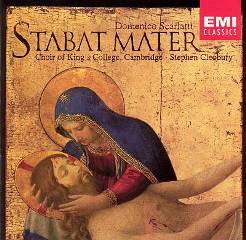Domenico Scarlatti - Te Deum, Stabat Mater, Miserere, Magnificat e Laetatus sum (2009)
Domenico Scarlatti - Te Deum, Stabat Mater, Miserere, Magnificat e Laetatus sum (2009)

01. Te Deum - I. Te Deum laudamus 02. Te Deum - Te ergo quaesumus 03. Stabat Mater - I. Stabat mater dolorosa 04. Stabat Mater - II. Cujus animam gementem 05. Stabat Mater - III. Eja mater, fons amoris 06. Stabat Mater - IV. Sancta mater, istud agas 07. Stabat Mater - V. Fac me vere tecum flere 08. Stabat Mater - VI. Juxta crucem tecum stare 09. Stabat Mater - VII. Inflammatus et accensus 10. Stabat Mater - VIII. Fac ut animae donetur 11. Stabat Mater - IX. Amen 12. Miserere 13. Magnificat - I. Magnificat anima mea Dominum 14. Magnificat - II. Fecit potentiam 15. Magnificat - III. Gloria Patri 16. Laetatus sum - I. Laetatus sum 17. Laetatus sum - II. Propter fratres meos 18. Laetatus sum - III. Gloria Patri Choir of King's College, Cambridge Stephen Cleobury - conductor + Joseph Crouch – cello (1, 15) Ashley Grote – organ (1, 15) Daniel Hyde – organ (3) Richard Butler – tenor (9) Nicholas Daly – treble (9, 15) Timothy Mead – alto (15)
Domenico Scarlatti’s Stabat mater is, and seems always to have been, among the most popular of his comparatively small number of sacred vocal pieces. He probably wrote it between the years 1708 and 1728 when he was primarily employed as a church composer in Rome and in Lisbon. His setting of the 13th-century text is in ten parts divided into four soprano strands, two alto, two tenor and two bass with continuo. The style – a blend of older techniques with more up-to-date means of expression – is curiously anonymous and fails to sustain interest throughout. But it has many attractive ideas and its craftsmanship is well sustained. Several recordings of the piece are available, some preferring one voice to a part to the more chorally inclined version favoured here by the Choir of King’s College, under its director Stephen Cleobury. The singing is bright, fervent and generally secure, though there are a few uncomfortable moments especially evident in the opening section of the work. Scarlatti’s sustained but never antiphonal aura of sound is greatly enhanced by the acoustic of King’s College chapel, which suffuses the performance with radiance. Most other versions, though overall more vocally secure, lack this vital dimension. But one, at least, deserves mention. The French Ensemble William Byrd, directed by Graham O’Reilly, preferring one voice to a part, gives a beautifully lucid performance in the comparably effective but entirely different acoustic of the Abbey of Saint-Michel-en-Thiérache. It’s well worth seeking out, and not least for its inclusion of the warmly expressive little hymn Iste confessor. --- Nicholas Anderson, classical-music.com
download (mp3 @320 kbs):
yandex 4shared mega mediafire zalivalka cloudmailru uplea








